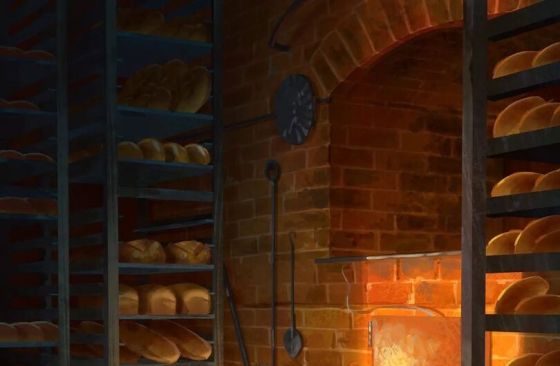Difference between revisions of "Bakery"
Tao alexis (talk | contribs) |
Tao alexis (talk | contribs) |
||
| Line 13: | Line 13: | ||
Hard wood is used throughout for the furnishings. The interior walls are made of glazed brick placed against a slat-wood exterior. The floor is left of earth, which though less than desire, will stand up better to the constant heat than wood or brick. The latter has a tendency to crack, the pieces having a knack of getting loose. The earthen floor is regularly limed to put rats and mice off from burrowing. | Hard wood is used throughout for the furnishings. The interior walls are made of glazed brick placed against a slat-wood exterior. The floor is left of earth, which though less than desire, will stand up better to the constant heat than wood or brick. The latter has a tendency to crack, the pieces having a knack of getting loose. The earthen floor is regularly limed to put rats and mice off from burrowing. | ||
| + | |||
| + | == Production == | ||
| + | A bakery makes use of some 280 lbs. of flour per day, including that which the bakery itself grinds. This is baked into 80 loaves that, with water included, weigh 320 lbs., at ½ to 2 lbs. per loaf. Adults in the 17th century ate between 1 and 1½ lbs. of bread per day., so that this amount is sufficient for 256 persons. Members of the baker's family carry bread to others in the hex, with more sold to travellers and the excess is broken and used as feed. | ||
| + | |||
| + | Price varies, but a typical half-lb. loaf of wheat bread may be counted as 2 [[Coin (monetary unit)|copper pieces]]. The party can make use of this benefit. | ||
| + | |||
| + | |||
| + | See also,<br> | ||
| + | [[Hammer (symbol)]] | ||
Revision as of 21:03, 24 December 2022
Bakeries are establishments that produce and sell flour-based food baked in an oven, especially bread. The burden of making bread in a single-family home encourages the purchase of bread from a baker. Time saved is used by goodfolk to better improve their homes and lives in other ways. This is especially important in backcountry places, such as hamlets, where additional time allows residents to better forage or give more time to farm animals and crops. This increases the general food supply, and the variety of food, so that bakeries increase a region's collective health.
In rural settings, farmers pay for their bread with grain provided at harvest time, that allows an account of so many loaves per week throughout the year. Others, except the miller, who pays for bread with flour, must have coin. This makes the bakery in a hamlet or small village a most important facility, a reliable commercial concern and a matter of attention for the whole community. In towns and cities, the baker's guild brings bread to every home within the urban unit.
Company
A bakery operation consists of two journeyfolk — qualified workers at the craft – and their families, with three apprentices younger than 16. The apprentices live in spaces above the bakery, with other stores, while the journeyfolk reside in nearby slat houses. The total compliment, including extended family, is 4d4+3 persons (7-19).
Construction
Good construction desires the bakery to be nearly square rather than long and narrow; the latter makes for long runs from one end of the bakery to the other. The most common space is 25 ft. square, but 30 ft. on a side is better. The building is usually sunken five feet below street level to better contain the heat while enabling a faster cooling when the ovens are shut down.
A large clear space is left around the oven, or ovens, to allow the free play of the peel rod when anyone is working. Troughs are placed against the walls and away from the ovens. The bakery table is placed so that workers are able to work on all sides of it. Shelves for the bread are set against one wall, from floor to ceiling, so that customers can observe the product.
Hard wood is used throughout for the furnishings. The interior walls are made of glazed brick placed against a slat-wood exterior. The floor is left of earth, which though less than desire, will stand up better to the constant heat than wood or brick. The latter has a tendency to crack, the pieces having a knack of getting loose. The earthen floor is regularly limed to put rats and mice off from burrowing.
Production
A bakery makes use of some 280 lbs. of flour per day, including that which the bakery itself grinds. This is baked into 80 loaves that, with water included, weigh 320 lbs., at ½ to 2 lbs. per loaf. Adults in the 17th century ate between 1 and 1½ lbs. of bread per day., so that this amount is sufficient for 256 persons. Members of the baker's family carry bread to others in the hex, with more sold to travellers and the excess is broken and used as feed.
Price varies, but a typical half-lb. loaf of wheat bread may be counted as 2 copper pieces. The party can make use of this benefit.
See also,
Hammer (symbol)
